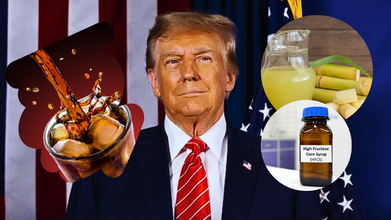- Health Conditions A-Z
- Health & Wellness
- Nutrition
- Fitness
- Health News
- Ayurveda
- Videos
- Medicine A-Z
- Parenting
- Web Stories
How Naturopathy Uses Greens Like Brahmi and Moringa to Promote Detoxification and Gut Health

In the realm of naturopathy, therapeutic meals are more than just food; they're a form of medicine. A strong focus is placed on natural greens such as Brahmi and Moringa, not only for their rich nutritional profiles but also for their detoxifying and gut-cleansing properties.
Gut Cleansing and Detoxification
“Gut cleansing refers to the detoxification process of the digestive system, mainly the large intestine,” explains Dr Narendra K Shetty, Chief Wellness Officer at Kshemavana Naturopathy and Yoga Centre. He emphasises the importance of using nutrient-rich plants like Moringa and Brahmi to aid this natural process.
According to Dr Shetty, Moringa oleifera is a powerhouse of nutrients. “It is a nutrient-rich source of proteins and antioxidants, minerals as well, such as potassium, zinc, magnesium, iron, sodium, calcium, and copper, vitamins A, D, C, E, folic acid, pyridoxine, and nicotinic acid as well as nutrients such as essential amino acids, antioxidants, flavonoids, and isothiocyanates are abundant,” he says.
Healing from Within
Dr Shetty further explains that Moringa's fibre content is vital for healing and muscle building. “Anti-ulcer/gastroprotective activity which contains bisphenol and flavonoids found in moringa leaves shows reduced levels of ulcer index, duodenal ulcers and stress ulcers in the ibuprofen-induced gastric ulcer model,” he adds.
Not just that, “it significantly reduces the free radicals and neutralises the acidic behaviour of gastric juice. Moringa’s combination of antioxidants and anti-inflammatory properties enhances liver function, aiding the body’s natural detoxification process.”
He recommends that “regular consumption of organic Moringa leaf powder helps cleanse the system.”
Brahmi also plays a pivotal role in gut health. “Brahmi is able to decrease the frequency of defecation and play a role as an anti-diarrhoeal herb. It was found that it alleviates acetic acid-induced penetrating ulcers and strengthens the mucosa barrier,” says Dr Shetty. Known for its detoxifying effects, Brahmi helps cleanse the body by removing accumulated toxins, allowing for better circulation and organ function.
Thus, we can conclude that Moringa and Brahmi help in detoxification and promote gut health.
Naturopathy’s Nutritional Wisdom
Dr Shivaprasad Shetty of Yoga and Nature Care, Shantivana, says these wild Indian greens should be integrated into everyday meals to support digestive health and overall well-being.
“Brahmi is known for its cognitive function,” he says, adding that it may interact with sedatives, and individuals should consult a doctor if taking medications. The benefits, he shares, include “stress reduction” and “memory enhancement”.
Regarding Moringa, Dr Shivaprasad points out its “antioxidant properties” and “heart health support” but cautions that it may interact with blood thinners and diabetes medications. “It is nutrient-rich (minerals, vitamins),” he says.
How to Add Brahmi and Moringa to Your Diet
According to Dr Shivaprasad, there are various ways to include these greens in therapeutic meals:
- Salads – “Add fresh leaves to salads”
- Smoothies – “Blend into juices (add banana, almond milk, honey)”
- Soups – “Add to stews”
- Teas – “Make herbal teas from dried leaves”
“Brahmi and Moringa are rich in nutrients used in naturopathy for benefits like gut cleansing, high fibre content, rich chlorophyll, and detoxification,” he explains.
A Word of Caution
Before making any major dietary changes, Dr Shivaprasad advises, “Consult the healthcare professional before making significant dietary changes.” He also stresses the importance of “proper identification and sourcing of wild greens.”
Through the lens of naturopathy, greens like Brahmi and Moringa are not just food; they’re healing agents, working quietly and effectively to detoxify the body and restore balance from within.
Why The Obesity Crisis Won’t End Unless We Change The Way We Live, Eat And Move

Credits: Health and me
Telling people to “eat less and move more” isn’t working. If it were, we wouldn’t be facing a growing obesity crisis, staggering healthcare costs, and lives eroded by stigma and chronic illness. The problem isn’t individual failure it’s systemic.
Obesity is real, chronic, and deeply rooted in our biology, environment, and society. Yet for years, policy responses have focused on personal responsibility, leaving millions to fend for a solution that only lasts till the next trip to the grocery store. To truly address this crisis, everything from individual care to global food systems must changes.
We’ve been sold the myth that weight gain is simply a matter of willpower and to eat less, move more. But emerging science tells a different story- obesity is a chronic relapsing condition, driven by a tangle of genetic, psychological, socioeconomic, and environmental forces.
In England, 26.5% of adults live with obesity. Among children aged 10–11, that number is 22.1%. Beyond fat and numbers, obesity carries heavy consequences: heart disease, type 2 diabetes, poor mental health, and more. It is estimated to cost the UK £126 billion annually—covering NHS services, unemployment, lost quality of life, and informal care support. And it’s only getting worse; by 2035, this could rise to £150 billion a year.
It’s time to recognize obesity as more than a lifestyle issue. It’s a disease born in context and reinforced by neglect.
Is The “Obesogenic” Environment Built Just for Weight Gain?
In 2007, the UK’s Foresight report introduced “obesogenic environment”—a world where high-calorie ultra-processed foods are cheap and ubiquitous, and physical activity is less necessary than ever. This isn’t accidental—it’s engineered.
Our cities encourage driving over walking. Junk food dominates retail shelf space. Work and leisure revolve around screens. In many neighborhoods, healthy options are scarce, thanks to food deserts, poor public transit, and lack of green space.
These aren’t universal conditions. Communities with lower income face disproportionately higher exposure to these obesogenic environments. That biological response to unhealthy surroundings is not a failing—it’s expected.
It’s easy to shift blame onto individuals. But telling someone to lose weight without addressing the systemic obstacles is like asking someone to swim upstream while you drain the river.
Weight stigma thrives in this climate. Without understanding obesity's roots, people struggling with weight are often labeled as lazy or undisciplined. That stigma breeds shame and discourages seeking care—especially childhood, when a lifetime of self-consciousness can begin but data shows the real drivers: deprivation correlates with rising obesity rates, especially among kids. Our approach must evolve from blame to empathy and evidence-based support.
Why it Is Important to Reframe Obesity?
To create meaningful change, we must dismantle three harmful myths:
- Obesity is a personal failure.
- Weight loss is about willpower alone.
- Short-term diets and exercise plans are solutions.
Instead, care must be rooted in medical science and social context. Here’s how:
1. Recognize Obesity as a Disease
Health systems need to treat obesity like chronic conditions—diabetes, asthma, depression—not as an afterthought. This means consistent assessment, structured interventions, and multi-year follow-ups.
2. Confront Weight Stigma
Weight-based bias is tolerated in schools, workplaces, and clinics. This must stop. Clinicians and educators require training to adopt respectful, person-centered language and practices. Public health campaigns should back this shift away from blame.
3. Deliver Tailored, Holistic Care
No one-size-fits-all. Treatment plans must consider genetics, culture, environment, mental health, and lifestyle. Follow-up must be more than numbers on a scale. Shared decision-making, psychological support, and mindful goal-setting are critical.
4. Change Surrounding Environments
To make healthy living feasible, the environment must support it. That means:
- Expanding the sugar tax to all sugary beverages and high-sugar foods.
- Reformulating ultra-processed foods to reduce calories, salt, fat, and sugar.
- Mandating clear labelling and restricting advertising of unhealthy foods, especially to children.
- Investing in public transit, affordable fresh food, and accessible parks, especially in underserved areas.
- Implementing workplace health-friendly policies—standing desks, active transport rewards, fresh food in cafeterias.
This isn’t about personal choice—it’s about choice architecture.
What Are The Economic, Social, and Ethical Stakes Of obesity Crisis?
The cost of obesity isn’t only financial. There’s a social toll: family stress, workplace discrimination, mental health crises. Governments are waking up to the reality: ignoring systemic factors isn’t just irresponsible—it’s reckless.
Expanding sugar taxes alone could raise billions annually, reduce consumption, and fund essential public services. When coupled with broader reforms, these policies can shift cultural norms and industry incentives.
Moreover, recognizing socioeconomic factors—housing, education, income inequality—changes the narrative. It places the problem in context, not on individuals already struggling to stay afloat.
Everyday Steps That Need Redefining
A systems approach doesn’t erase personal responsibility—it reframes it. People matter in the solution, but environments and systems matter more. Imagine a world where:
- Free nutrition counseling is available during pediatric checkups.
- Primary care physicians routinely screen for weight stigma and mental health.
- Urban planners make biking as safe and common as driving.
- Grocery stores compete based on healthy food affordability.
- Schools offer fresh meals, cooking classes, and daily movement.
- Employers design breaks and infrastructure to support employee wellness.
That’s not future talk—it’s policy within reach. These aren’t random ideas—they’re pieces of an integrated solution.
Why We Need the Shift Now?
We face a choice: continue business-as-usual and watch costs and suffering escalate, or embrace a comprehensive public health approach. The evidence is clear. Individual change without systemic transformation is a drop in the bucket.
Treating obesity as a chronic disease, ending stigma, delivering personalized support, and redesigning our environments represent a paradigm shift. And yes—it will require political will, public will, and significant change in how we talk about weight but the payoff is enormous with lives spared, healthcare systems stabilized, and children unburdened by preventable disease and shame. It’s not just about waistlines—it’s about equity and human dignity.
If the goal is to support healthier populations—and healthier systems—then blaming individuals for obesity is both harmful and counterproductive. The “eat less, move more” era is over.
To tackle obesity, we must reframe it from a personal failing to a collective challenge. That means shifting from judgment to understanding, from short-term fixes to long-term systems. From individual blame to societal accountability because real health isn’t about individual transformation alone—it’s about transforming the world we live in.
5 Healthy Foods For Your Dental Health

Credits: Canva
During the COVID-19 pandemic, many people missed their routine dental check-ups. This has left them wondering how their dental health may have been impacted. However, while dentist visits matter, your diet plays a major role in keeping your teeth and gums healthy.
According to dental experts, eating foods rich in nutrients like calcium, phosphorus, magnesium, and vitamin D, and low in sugar and processed carbs, can protect against cavities, bleeding gums, and other oral health issues. On the flip side, some common foods — even those considered healthy — may damage your teeth if consumed regularly.
Here’s a look at five foods that support oral health and five that may be harming it.
5 Foods That Are Great for Your Teeth
Cacao Nibs or Dark Chocolate
Cacao nibs — or unsweetened dark chocolate — contain polyphenols that help kill cavity-causing bacteria and prevent plaque from sticking to teeth. Research shows cocoa compounds can be as effective as mouthwash in reducing harmful bacteria, without affecting the good ones. Just be sure to choose chocolate with little to no added sugar.
Grass-Fed Dairy
Cheese, butter, and other dairy products from grass-fed animals are rich in vitamin K2, a nutrient that supports tooth mineralization and overall dental health. Many people are deficient in K2, and grass-fed dairy offers a natural source. Other good sources include eggs, chicken liver, and natto.
Fatty Fish
Fish like salmon, tuna, mackerel, and trout are packed with vitamin D and omega-3 fatty acids, which help strengthen tooth enamel and reduce gum inflammation. Vitamin D also helps deliver calcium to teeth — a key part of preventing decay.
Leafy Greens
Spinach, kale, and Swiss chard are high in minerals and act as prebiotics in the mouth. They support beneficial bacteria and help produce nitric oxide, which can benefit both oral and heart health. Leafy greens also help clean your teeth naturally and strengthen enamel.
Grapefruit and Oranges
While acidic, citrus fruits like oranges and grapefruit provide vitamin C, which helps reduce gum inflammation and supports healthy connective tissues in the mouth. Studies show they may even reduce bleeding gums. Just rinse your mouth with water afterward to limit acid exposure.
5 Foods That Can Harm Your Dental Health
Crackers and Processed Carbs
Don’t let their bland flavor fool you — crackers quickly break down into sugars, feeding harmful bacteria that cause decay. They’re often more damaging than candy. If you crave something crunchy, choose seed-based options without wheat or refined carbs.
Dried Fruits
Sticky and sweet, dried fruits like raisins and apricots cling to teeth and are high in sugar. They also have a low pH, making them acidic and more likely to erode enamel. Whole, fresh fruit is a better choice.
Soda
Soda is one of the most acidic beverages on the market, with or without sugar. Its pH can weaken enamel and lead to cavities. Sip it quickly, not slowly over time, and rinse with water afterward. Wait at least 45 minutes before brushing.
Kombucha
Often seen as a health drink, some kombucha brands contain added sugars and lack active probiotics. These sweet and acidic drinks can harm your teeth if consumed regularly. Choose sugar-free versions with visible fermentation and rinse after drinking.
Beans and Lentils
Though nutritious, legumes contain phytic acid, which can interfere with the absorption of calcium and magnesium — minerals your teeth need. If you rely heavily on these foods, make sure you’re getting enough of the key nutrients from other sources.
Donald Trump Says Cane Sugar Is ‘Just Better’ Than Corn Syrup, But Is It Really Healthier?

The U.S. President Donald Trump recently made a bold health claim, or rather, a taste claim. In a Truth Social post, he announced that Coca-Cola had agreed to swap high-fructose corn syrup (HFCS) for “REAL Cane Sugar” in its U.S. sodas. He thanked the brand and proclaimed, “It’s just better!”
But does this sugar switch mean your Coke just got healthier, or is this simply a case of swapping one sweetener for another? Let us find out what really sets these sugars apart and whether your body knows which one you are sipping.
Cane Sugar vs Corn Syrup: What is the Difference?
Cane sugar, also known as sucrose, comes from the sugarcane or sugar beet plant. It is the classic granulated white sugar many of us grew up baking with. High-fructose corn syrup, on the other hand, is a man-made sweetener derived from corn starch. Through a process involving enzymes, the corn starch is converted into a mixture of glucose and fructose.
While both are composed of glucose and fructose, cane sugar is typically a 50/50 split. HFCS used in sodas often contains 55 per cent fructose and 45 per cent glucose. That small bump in fructose might not seem like a big deal, but when consumed in large amounts, it could have different effects on the body.
How They Are Processed
Cane sugar production is relatively simple. Sugarcane is crushed, and its juice is extracted, boiled, filtered, and crystallised. It is an age-old process with minimal tinkering.
HFCS, however, is the result of industrial alchemy. It begins as corn, which is milled into corn starch, then enzymatically treated to convert some of the glucose into fructose, a process that is neither short nor natural. It is a cheaper sweetener, which is why U.S. manufacturers widely embraced it in the 1970s.
In terms of “natural” credentials, cane sugar might win. But the real question is, how does each sweetener behave once it hits your bloodstream?
How They Impact Your Body
The body breaks down both HFCS and cane sugar into fructose and glucose. Glucose fuels your cells and raises blood sugar, prompting insulin production. Fructose, meanwhile, is metabolised by the liver. In excess, it can contribute to fatty liver disease, insulin resistance, and increased triglycerides, meaning it is not ideal for your heart or waistline.
A slight increase in fructose in HFCS may make it more lipogenic, or fat-producing, particularly in the liver, according to some research. But when cane sugar is consumed in high quantities, it is not exactly a health food either.
The Burning Question: Is Cane Sugar Actually Better?
Taste-wise, many people say yes. It is often described as cleaner and less cloying. That is why Mexico’s Coca-Cola, made with cane sugar, has long enjoyed a cult following in the U.S., even earning the nickname “Mexican Coke”.
Health-wise, however, it is a marginal difference. The real issue is not which sweetener you choose; it is how much of it you are guzzling. The American Heart Association recommends no more than 25 grams of added sugar per day for women and 36 grams for men. That is about the amount in one can of soda, whichever sugar it is made with.
© 2024 Bennett, Coleman & Company Limited

